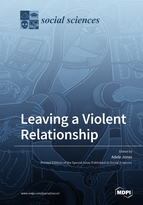Leaving a Violent Relationship
A special issue of Social Sciences (ISSN 2076-0760).
Deadline for manuscript submissions: closed (31 July 2020) | Viewed by 46547
Special Issue Editor
Special Issue Information
Dear Colleague,
Intimate partner violence (IPV), defined as physical, sexual, emotional and economic abuse and controlling behaviours inflicted within intimate partner relationships is a global crisis that extends beyond national and sociocultural boundaries, affecting people of all ages, religions, ethnicities and economic backgrounds. Although women can be violent towards male partners and IPV occurs in same-sex partnerships, it is most commonly perpetrated by males towards females, and the overwhelming global burden of IPV is thus borne by women. People often ask of women in abusive relationships “why does she stay?” Critics suggest that this question carries implicit notions of victim blame and fails to hold to account the perpetrators of abuse. Targeted at the individual, it can mask societal and institutional failings that create barriers to leaving (Barnett, 2000). A better question might be “why doesn’t he stop?” since this would direct attention to the limitations of criminal justice systems and the multiple ways through which violence against women is perpetuated (Jones and Jemmott, 2014). Our purpose here, however, is survivor agency, and evidence suggests that most abused women are not passive victims but develop strategies for surviving abuse; indeed, in some contexts, not leaving may be a calculated survival decision (Heise et al. 1999). Impediments to escaping abuse have long been recognised as multifaceted (Anderson et al. 2003), but the discursive terrain has changed; across the globe, public disinterest about IPV seems to be giving way to public disquiet, largely as a consequence of renewed local and international activism (evidenced, for example, by the #MeToo movement). Has this made accessing justice easier, has this made leaving less difficult and has this opened up other routes to safety so that leaving is no longer the best or only option? We think it is timely to revisit the discussion. In this Special Issue of Social Sciences, we will explore topics related to the challenges of leaving a violent relationship.
We seek submissions based on rigorous, high-quality quantitative, qualitative, or mixed methods research, intersectional and comparative analyses that generate new insights into the topic. Manuscripts based on research with under-represented, minoritized or marginalized groups, or specific social contexts are particularly encouraged.
References
Anderson, M.A., Gillig, P.M., Sitaker, M. et al. (2003). Why Doesn't She Just Leave?”: A Descriptive Study of Victim Reported Impediments to Her Safety. Journal of Family Violence (2003) 18: 151. https://0-doi-org.brum.beds.ac.uk/10.1023/A:1023564404773
Barnett, O. W. (2000). Why Battered Women Do Not Leave, Part 1: External Inhibiting Factors Within Society. Trauma, Violence, & Abuse, 1(4), 343–372. https://0-doi-org.brum.beds.ac.uk/10.1177/1524838000001004003
Heise L, Ellsberg M, Gottemoeller M. (1999). Ending violence against women. Baltimore, MD, Johns Hopkins University School of Public Health, Center for Communications Programs.
Jones, A. D., and Jemmott, E. T. (2014). ‘Status, privilege and gender inequality: Cultures of male impunity and entitlement in the sexual abuse of children: Perspectives from a Caribbean study’, International Social Work
Prof. Dr. Adele Jones
Guest Editor
Manuscript Submission Information
Manuscripts should be submitted online at www.mdpi.com by registering and logging in to this website. Once you are registered, click here to go to the submission form. Manuscripts can be submitted until the deadline. All submissions that pass pre-check are peer-reviewed. Accepted papers will be published continuously in the journal (as soon as accepted) and will be listed together on the special issue website. Research articles, review articles as well as short communications are invited. For planned papers, a title and short abstract (about 100 words) can be sent to the Editorial Office for announcement on this website.
Submitted manuscripts should not have been published previously, nor be under consideration for publication elsewhere (except conference proceedings papers). All manuscripts are thoroughly refereed through a double-blind peer-review process. A guide for authors and other relevant information for submission of manuscripts is available on the Instructions for Authors page. Social Sciences is an international peer-reviewed open access monthly journal published by MDPI.
Please visit the Instructions for Authors page before submitting a manuscript. The Article Processing Charge (APC) for publication in this open access journal is 1800 CHF (Swiss Francs). Submitted papers should be well formatted and use good English. Authors may use MDPI's English editing service prior to publication or during author revisions.
Keywords
- Gender-based violence
- Violence against women
- Intimate partner violence
- Domestic abuse
- Gender
- Women
- Survivor
- Victim
- Perpetrator






